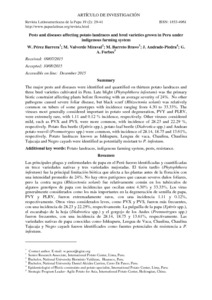The major pests and diseases were identified and quantified on thirteen potato landraces and three bred varieties cultivated in Peru. Late blight (Phytophthora infestans) was the primary biotic constraint affecting plants before flowering with an average severity of 24%. No other pathogens caused severe foliar disease, but black scurf (Rhizoctonia solani) was relatively common on tubers of some genotypes with incidence ranging from 4.30 to 33.33%. The viruses most generally considered important in potato seed degeneration, PVY and PLRV, were extremely rare, with 1.11 and 0.12 % incidence, respectively. Other viruses considered mild, such as PVX and PVS, were more common, with incidence of 28.23 and 22.29 %, respectively. Potato flea beetle (Epitrix spp.), potato leaf beetle (Diabrotica spp.) and Andean potato weevil (Premnotrypes spp.) were common, with incidence of 28.14, 18.75 and 13.61%, respectively. Potato landraces known as Ishkupuru, Lengua de vaca, Chaulina, Chaulina Tajacaja and Negro cayash were identified as potentially resistant to P. infestans
Pests and diseases affecting potato landraces and bred varieties grown in Peru under indigenous farming system
Citation: Perez, W.; Valverde Miraval, M.; Barreto Bravo, M.; Andrade-Piedra, J.L.; Forbes, G.A. 2015. Pests and diseases affecting potato landraces and bred varieties grown in Peru under indigenous farming system. Revista Latinoamericana de la Papa 19(2):29-41.
2015-12-11
POTATOES
SOUTH AMERICA
PERU
journal_article

